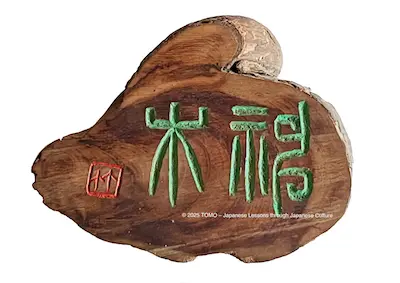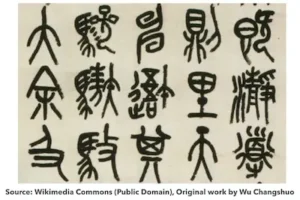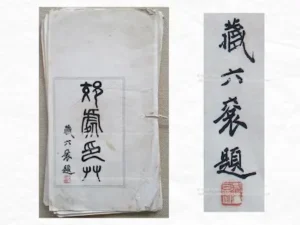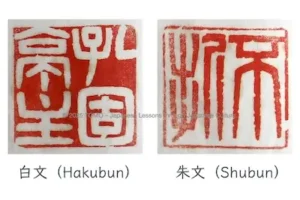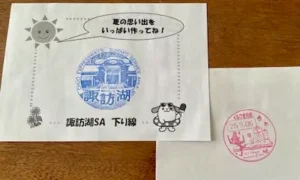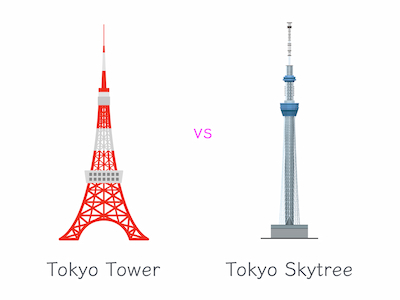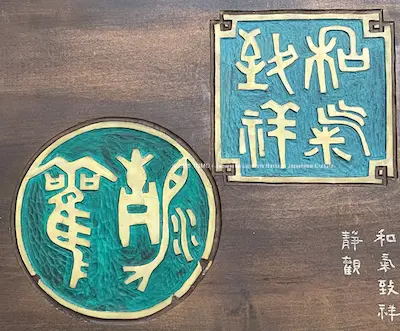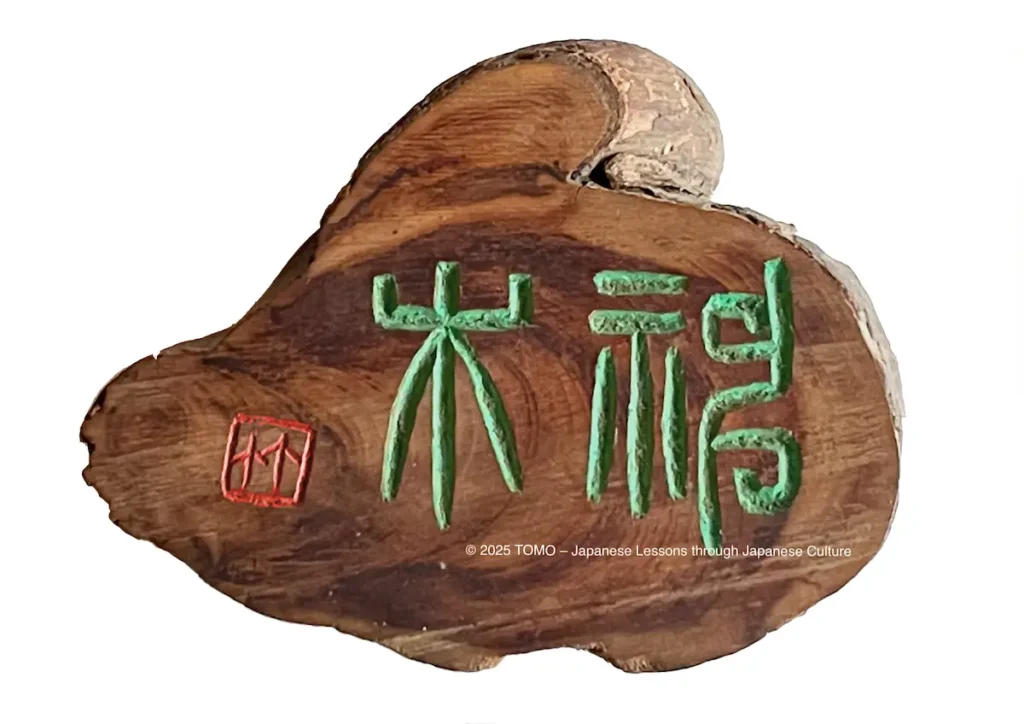
Japanese Seal Carving: Kōshō’s Story and Digital Art
The Meaning of “Mokufuku”: Happiness Carved in Wood
Encounter with the Work
“木福:Mokufuku” — a word that means happiness and blessings brought by trees.
It carries a wish for good fortune, a traditional Japanese charm for well-being.
The wood engraving in this photo was carved by one of my ancestors, Chikuson, on a tree stump at home.
Together with another seal engraver, Kōsho, his warm style and spirit have been quietly passed down through generations.
It was likely a practice piece, created during his daily work.
Yet within it, I can feel a joy of living with nature and finding happiness in ordinary life.
In Japanese culture, people often express wishes and prayers through words and art.
The phrase Mokufuku embodies that gentle way of seeing the world.
When I first saw this work, I was deeply moved by its simple warmth.
The Passage of Time
Over the years, the wood’s texture and the color of the carved seal slowly softened.
It was not mere fading, but a story told by time — a quiet beauty shaped through the years.
My Involvement and Restoration
As a descendant, I wondered what I could do to honor this piece.
In the past, I worked in art reproduction, color adjustment, and large-format printing.
Using that experience — along with my Color Coordination Certification — I tried to digitally restore the original tones of the work.
While preservation belongs in museums, I wanted to share the beauty of this piece with more people.
Connecting Warmth to Language and Culture
As a Japanese language teacher, I share not only words but also the culture and emotions behind them.
Through this artwork, I felt the warmth of my ancestor’s craftsmanship and wanted to introduce it to others.
My experience as a teacher and my deep respect for this art have given this restoration a special meaning.
The Beauty of Seal Carving Told Through Color and Time
Pigments and the Expression of the Era
There are no written records about this work.
However, based on the historical background and the materials used at that time, I tried to imagine how it might have been created.
Color of the characters: Rokushō (verdigris green)
In this work, the characters are colored with rokushō, a natural pigment made by oxidizing copper.
Its deep, muted green changes depending on the coarseness of the pigment particles.
This pigment has long been used in temple roofs and traditional Japanese paintings.
Sometimes it was also used for backgrounds in calligraphy or artwork.
Possible color of the seal: Shu (vermilion) or Bengara (red iron oxide)
Most Japanese seals are stamped in red.
You can also find artists’ seals on calligraphy and signboards.
This work was created by Chikuson, who used the first character of his name, “竹” (take, meaning bamboo).
For his seal, he likely used one of the following pigments:
- Shu (vermilion): a vivid red pigment made from cinnabar, well known as the color of traditional ink paste.
- Bengara: a reddish-brown pigment made mainly from iron oxide. It was cheaper than cinnabar and had a softer, earthy tone.
To fix the pigments: Nikawa (animal glue)
Nikawa is a natural adhesive made by boiling animal skin, bones, or tendons to extract collagen.
It was used to bind pigments like rokushō and help them adhere to the surface.
Before & After
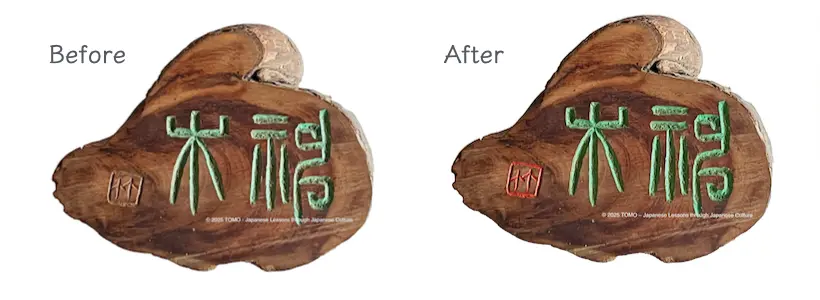
Before:
Over the years, the wood and seal marks have mellowed in color.
This aging is not simply deterioration—it tells the story of time and gives the piece a warm, quiet expression.
After:
Using digital restoration, I tried to revive the original tone of the colors.
The green of rokushō tends to fade easily, so I gently added color to bring back its brightness.
Although the seal area originally had no pigment, I tried applying shu to visualize its possible appearance.
The Warmth of the Work
When I imagine my ancestor creating this piece as part of his daily work, I can feel the warmth of his craftsmanship.
The stump of wood itself still retains its gentle texture and presence.
Even in such a simple, personal work, his personality and heartfelt touch come through.
Touching this work connects me to the warmth and sincerity of my ancestor’s hands.
As a Japanese language teacher, I try to share that same warmth—the heart behind words and culture.
Through this work, I hope to convey how beauty and kindness can live quietly in everyday things.
Conclusion
Thank you very much for reading until the end.
Through this seal carving, I could feel my ancestor’s craftsmanship and care.
Over time, its colors have gently changed, adding warmth and quiet beauty to the work itself.
Each tone and expression carries a long history and heartfelt intention.
Just like this piece, I hope to continue sharing the beauty of Japanese culture and handmade art with you.
May this story inspire you to notice the quiet warmth and small stories that exist in everyday life.
Please take a moment to read the story behind the seal carving featured in my website header.:
[The Seal Carving by My Ancestor in My Website Header]
Japanese of the Day / 今日の日本語
- Word:__ ぬくもり (nukumori) – warmth
- Meaning:“ぬくもり” means gentle warmth, both physical and emotional.
It describes the comforting feeling of something handmade, a kind person, or even sunlight. - Example:この作品には、人の手のぬくもりを感じます。(Kono sakuhin ni wa, hito no te no nukumori o kanjimasu.)
You can feel the warmth of a human touch in this work. - Fun Fact:“ぬくもり” often appears in Japanese poetry, songs, and ads to express kindness and emotional closeness
— a concept deeply valued in Japanese culture.
Explore the Japanese Culture Course
My Japanese Culture Course values not only the surface beauty of works like this one.
It also honors the warmth and depth of culture behind them.
With my experience as a Japanese language teacher, I guide you through the heart of Japan.
My deep love for Japanese culture allows me to share its landscapes and stories with you.
Please check the details of the [Japanese Culture Course].
◆ Would you like to talk about Japanese culture? ◆
In the Culture Course, you can learn to speak about Japanese culture with me.
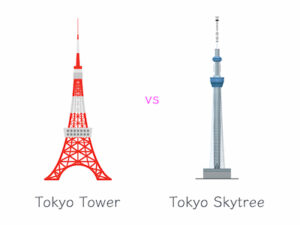
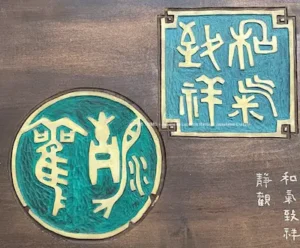
作品を通して伝える日本文化
作品との出会い
「木福(もくふく)」──木がもたらす幸福や恵みを表す、縁起のよい言葉です。
こちらの写真の篆刻作品。実は、先祖の一人である竹邨(ちくそん)が自宅にあった木の切り株に刻んだものです。
同じく篆刻家の郊処(こうしょ)とともに、その温かな作風と精神は、時を越えて今も静かに受け継がれています。
おそらく日々の制作の傍らで生まれた練習用の作品でした。
けれども、その中には、「木とともに暮らす喜び」や「日常の中に福を見いだす心」が感じられます。
日本の言葉には、願いや祈りを形にして残す文化があります。
この「木福」という言葉にも、そんな日本人のやさしいまなざしが息づいているように思います。
初めてこの作品を目にしたとき、その素朴な温かさに心を奪われたのを覚えています。
時間の経過の描写
長い年月を経て、木肌や印影の色は少しずつ落ち着き、独特の深みを帯びるようになりました。
単なる劣化ではなく、時間を物語る、特別な味わいがそこにありました。
作品への関わりと試み
子孫としてできることは何かと考えました。
以前、絵画の複製や色調整、大判プリンタでの出力に関わる仕事をしていました。
そこで培った経験や色彩検定の知識を活かし、制作当初の色をデジタルで甦らせる試みに挑戦しました。
保存は美術館に任せ、作品の魅力を多くの人に知ってもらいたいと思ったからです。
作品の温かさを日本語と文化に活かす
私は日本語教師として、学習者の方に日本語と文化を伝えてきました。
そして、この作品を通して先祖の手仕事や温かさに触れ、それを皆さんに紹介したいと思っています。
日本語教師としての経験と篆刻作品への想いが重なり、この修復への挑戦にも特別な意味が生まれました。
色と時間が語る篆刻の魅力
顔料から見る当時の表現
記録が残っていないため、はっきりとはわかりませんが、時代背景や当時の様子をもとに考えてみました。
文字の色:緑青(ろくしょう)
今回の作品では文字の色に使われています。
文字の他にも文字や絵の背景の色としても使われることもあります。
- 銅の酸化によってできる天然顔料。深みのある、くすんだ緑色が特徴です。粒子が粗いほど色が濃くなります。
- 神社やお寺の屋根、日本画などに用いられています。
印の色の可能性:朱(しゅ)・弁柄(べんがら)
日本の多くの印は朱色で捺印されています。そして、書や看板などにも作家の印が刻まれています。
この作品は竹邨(ちくそん)が制作しました。名前の最初の漢字「竹」を使っています。
その際使われた顔料です。
- 朱(しゅ): 辰砂と同じ原料から作られる、朱肉の色として知られる赤色です。
- 弁柄(べんがら): 酸化鉄を主成分とする顔料。辰砂に比べて安価で、赤褐色の色合いです。
色を定着させるための「にかわ」
- 原料: 動物の皮や骨、腱などを煮て抽出したタンパク質でできた天然の接着剤です。
- 用途: 彩色する際、顔料(緑青など)を定着させる接着剤として使われます。
Before & After
- Before:修復前の作品。長年の時を経て木肌や印影は落ち着いた色合いに。
単なる劣化ではなく、作品が歩んできた時間を感じさせる温かい表情。 - After:制作当初の色をデジタルで再現。時間の経過で落ち着いた色合いを丁寧に甦らせました。
文字の緑青は色が抜けやすいようです。そのため、色をのせて、当時の鮮やかさを引き出しました。
印の部分に色はありませんでしたが、朱をのせてみました。
作品の温かさ
この作品は、先祖が日々篆刻に向き合う中で生まれたものかもしれないと想像すると、手仕事の温かさが感じられます。
また木の「切り株」をそのまま使った作品は、木の温もりも残っています。
こうした身近な作品にも、先祖らしさや心のこもった温かみが表れているのだと思います。
この作品に触れることで、先祖の手仕事や温かさを感じる体験は、言葉や文化の奥にある心の豊かさを読み解く姿勢と重なります。
また、日本語教師として、言葉の奥にある温かさを伝えるように、作品の魅力も丁寧に読み取り、皆さんに紹介したいと思います。
まとめ
最後までお読みいただき、ありがとうございます。
この篆刻作品を通して、先祖の手仕事や時間の経過による色彩の変化、そして作品に込められた温かさに触れることができました。
色や表現の一つひとつには、長い年月を経た歴史と想いが宿っています。
これからも、この作品のように、日本の文化や温かい手仕事の魅力を皆さんにお伝えしていきたいと思います。
読者の皆さまが、日常の中で小さな物語や文化の温かさに気づくきっかけになれば幸いです。
ぜひ、私のウェブサイトのヘッダーにある篆刻の物語をご覧ください。
[The Seal Carving by My Ancestor in My Website Header]

